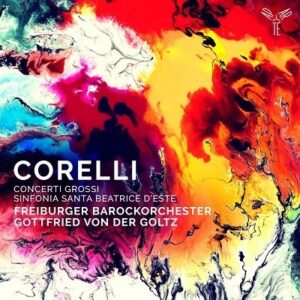The concerto grosso is a Baroque form in which the musical content is passed between a small group and a somewhat larger group, normally a pair of violins and a cello versus a still-smallish string section, with both groups being supported by continuo instruments. Arcangelo Corelli popularized the form, Geminiani, Torelli, and Handel followed with suites of concertos of their own.
Corelli’s Op. 6 set is rightly famous, and this recording presents six of the collection’s twelve concertos (Nos. 1-5 and No. 7) and a little sinfonia composed for the oratorio Santa Beatrice d’Este, which contains the central largo of the concerto No. 6. None of this would be news save for the fact that conductor (and arranger) Gottfried von der Goltz has opted to augment the usual strings with oboes, bassoon, trombones, and trumpets as well as a continuo consisting of lute, harp, harpsichord, and organ.
The D major concerto begins with an exciting mini-duo for violins—as slim as you can get—and a lute riff introduces the other strings (mostly normal); but suddenly, in the last 20 seconds of the first movement we are treated to some beautifully played trumpet fanfares, which return majestically at the start of the final movement. Von der Goltz argues that adding instruments was common practice and that Corelli himself took advantage of whatever instruments were at hand, but suspiciously, nothing was notated either during or after Corelli’s lifetime. Mmmm. In other words, it’s not gospel, and one must decide for oneself.
That having been said, von der Goltz certainly does not pull a Thomas Beecham-Messiah and bloat the proceedings: if anything, the additions may just be too discreet. If you’re going to do it, go for a big, or at least controversial, effect. Here we have our usual set of concerti grossi that are a bit shinier thanks to the trumpets and oboes, and a bit darker due to the three double basses and two cellos (and underpinning bassoon and organ). Von der Goltz is very polite and correct in his un-eccentric tempos, and the playing throughout is superb. And I really liked the effect in the C minor concerto, in which the Grave is played suitably gravely (and unadorned) and the contrasting, following Vivace features a delicious bassoon and a pair of oboes.
In short, I never felt bullied or put-upon, but 1) I felt that given the addition of the winds, I would have liked more vivid colors, and 2) I couldn’t help but wonder, is this really necessary? It’s a perfectly wonderful performance of these pivotal works but lacks the transparency and urgency of, say, Nicholas McGegan’s (on Harmonia Mundi). A fine oddity. You’ll know if you need this.
































